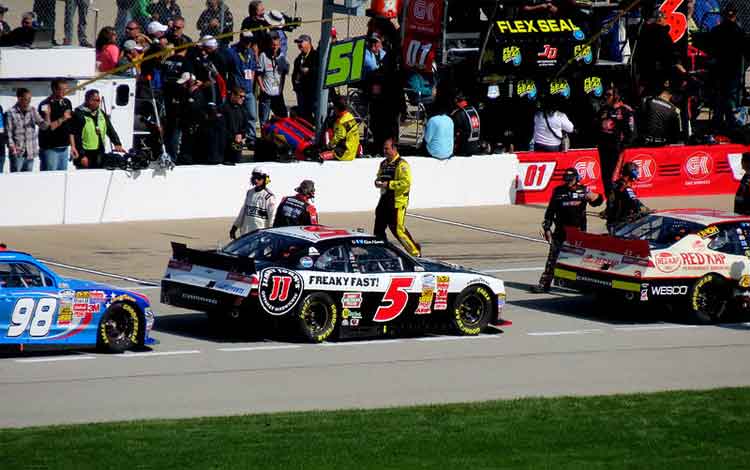Chances are if you’re a NASCAR fan, there are seemingly endless opportunities to watch racing on television. NASCAR racing is fast becoming an American phenomenon. With this increased popularity comes more competitors, better competition, and increased support from major automobile manufactures. This has led to many developments and advancements in racing technology, increasing the quality of racing. However, one major thing that has been overlooked is how the sport is presented on TV.
Speaking as a diehard NASCAR race fan, watching my favorite sport on television can get quite boring. Given this, I look to the television sports producers, commentators and analysts to make this seemingly boring “television sport” exciting for me, the passionate race fan. From a pre-race standpoint, they’ve done their job and done it splendidly with interesting features and driver interviews which enlighten and entertain. From the drop of the green flag however, their race coverage goes down hill fast. Being bombarded with logos, slogans, and advertisements, there seems to be something missing: exciting coverage of the race itself.

There is nothing that irritates me more than sitting through a countless number of commercials only to find out later that I’ve missed something exciting and have to watch it on a replay instead of live. Unlike most traditional sports, NASCAR doesn’t have “TV timeouts”. There is non-stop action happening lap after lap that is often missed and not aired live due to worthless commercials. Given that these commercials make it possible for me to watch the race for free and to watch it live, they are a necessary evil that are not going away anytime soon, no matter how inconvenient they may be. The way the commercials are presented can be improved upon however. ABC and ESPN have pioneered a commercial concept called “side-by-side,” when they cut away to a commercial during there racing broadcasts. These 2 networks don’t cover NASCAR yet, however this interesting concept puts the commercial and a live racing view in a picture-in-picture format on the screen. The audio is switched from the race to the commercial itself, which is in the bigger viewing window, with the live race feed in a smaller box on the corner of the screen. I find when I watch racing on ABC and ESPN, I miss none of the race action and have no reason to “channel flip” which means I’m fully exposed to the commercial’s message without missing a second of race action. This is the perfect solution that can be implemented rather easily with no significant drawbacks to the advertisers.
Another problem with the race television coverage of NASCAR racing are the camera views and angles used to show the race action. The technology involving the broadcasting of the races has changed greatly over the years. With the evolution of in-car cameras and wide-angle infield cameras, there are more available camera shots than ever before to capture the race at every angle. During the race broadcast however, these exciting race views are scarcely used. Rather, the same repetitive, monotonous camera angles are used time and time again during every single NASCAR race broadcast. ABC and ESPN have the same in-car camera technology available in their race broadcasts and they use it lap after lap. The only problem ABC and ESPN has is that in the type of open wheel racing they cover, the quality of racing, number of competitors, and the competition pails in comparison to NASCAR racing. When it comes to American auto racing, NASCAR is the place to be and is the most popular form of motorsport. NASCAR’s name recognition and popularity mixed with ABC and ESPN’s open wheel television coverage can create a very potent and powerful combination. Since the technology and cameras are already there and implemented on race weekends, the only thing needed to is to use what’s already available at the television network’s disposal. The only possible drawback to this plan is that the more time spent inside the car with the in-car camera views, the less time sponsor’s logos on the outside of the car will be seen by viewers on television. However this can be controlled by constantly switching camera angles and not spending too much time on one camera. I believe they should use a wider-variety of camera shots already available at their disposal, not just infield wide-angle or in-car shots. A balance between switching camera views by mixing exciting shots and shots which give more exposure to advertisers would be the best overall solution on improving NASCAR television coverage.

Reducing the amount of boredom during NASCAR race broadcasts is the only way to ensure the continued success of NASCAR racing. It’s essential that with the improved quality of racing, the television coverage reflects NASCAR racing at the most exciting angles possible, lap after lap, with commercials presented in a way that is the least intrusive and disruptive to the television viewing audience go here now. Better television coverage will lead to the continued growth of NASCAR and most important of all, sustain increased television ratings, keeping fans entertained and enthralled with the race action while drawing in new race fans. Ultimately this is in the best interest of all parties involved.











 My Karate Kid
My Karate Kid